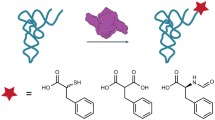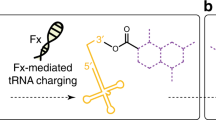Abstract
Here we describe a de novo tRNA acylation system, the flexizyme (Fx) system, for the preparation of acyl tRNAs with nearly unlimited selection of amino and hydroxy acids and tRNAs. The combination of the Fx system with an appropriate cell-free translation system allows us to readily perform mRNA-encoded synthesis of proteins and short polypeptides involving multiple non-natural amino acids.
*Note: In the version of this article initially published, the authors did not declare competing financial interests. They have filed a patent covering some of the information described in the paper and now declare competing financial interests. This error has been corrected in the PDF version of the article.
This is a preview of subscription content, access via your institution
Access options
Subscribe to this journal
Receive 12 print issues and online access
$259.00 per year
only $21.58 per issue
Buy this article
- Purchase on Springer Link
- Instant access to full article PDF
Prices may be subject to local taxes which are calculated during checkout


Similar content being viewed by others
Change history
19 July 2006
In the version of this article initially published, the authors did not declare competing financial interests. They have filed a patent covering some of the information described in the paper and now declare competing financial interests. This error has been corrected in the PDF version of the article.
References
Forster, A.C. et al. Proc. Natl. Acad. Sci. USA 100, 6353–6357 (2003).
Josephson, K., Hartman, M.C. & Szostak, J.W. J. Am. Chem. Soc. 127, 11727–11735 (2005).
Hecht, S.M., Alford, B.L., Kuroda, Y. & Kitano, S. J. Biol. Chem. 253, 4517–4520 (1978).
Robertson, S.A., Ellman, J.A. & Schultz, P.G. J. Am. Chem. Soc. 113, 2711–2729 (1991).
Wang, L., Brock, A., Herberich, B. & Schultz, P.G. Science 292, 498–500 (2001).
Xie, J. & Schultz, P.G. Methods 36, 227–238 (2005).
Link, A.J. & Tirrell, D.A. Methods 36, 291–298 (2005).
Murakami, H., Saito, H. & Suga, H. Chem. Biol. 10, 655–662 (2003).
Murakami, H., Kourouklis, D. & Suga, H. Chem. Biol. 10, 1077–1084 (2003).
Bain, J.D., Glabe, C.G., Dix, T.A. & Chamberlin, A.R. J. Am. Chem. Soc. 111, 8013–8014 (1989).
Noren, C.J., Anthony-Cahill, S.J., Griffith, M.C. & Schultz, P.G. Science 244, 182–188 (1989).
Hohsaka, T., Ashizuka, Y., Murakami, H. & Sisido, M. J. Am. Chem. Soc. 118, 9778–9779 (1996).
Shimizu, Y. et al. Nat. Biotechnol. 19, 751–755 (2001).
Murakami, H., Bonzagni, N.J. & Suga, H. J. Am. Chem. Soc. 124, 6834–6835 (2002).
Dedkova, L.M., Fahmi, N.E., Golovine, S.Y. & Hecht, S.M. J. Am. Chem. Soc. 125, 6616–6617 (2003).
Acknowledgements
We thank M. Komiyama for the use of MALDI instrumentation. This work was supported by grants from Japan Society for the Promotion of Science Grants-in-Aid for Scientific Research (S) (16101007) and from the US National Institutes of Health (GM59159).
Author information
Authors and Affiliations
Corresponding author
Ethics declarations
Competing interests
The authors declare no competing financial interests.
Supplementary information
Supplementary Fig. 1
Comparison of activity in flexizymes. (PDF 483 kb)
Supplementary Fig. 2
In vitro selection using Hbi-DBE. (PDF 564 kb)
Supplementary Fig. 3
In vitro selection using Phe-CME. (PDF 444 kb)
Supplementary Fig. 4
Fx-independent acylation of tRNA. (PDF 404 kb)
Supplementary Fig. 5
Acid substrates used in this study. (PDF 154 kb)
Supplementary Fig. 6
Site-specific incorporation of various acids into GFP. (PDF 528 kb)
Supplementary Table 1
Yields of acyl-tRNAs. (PDF 548 kb)
Rights and permissions
About this article
Cite this article
Murakami, H., Ohta, A., Ashigai, H. et al. A highly flexible tRNA acylation method for non-natural polypeptide synthesis. Nat Methods 3, 357–359 (2006). https://doi.org/10.1038/nmeth877
Received:
Accepted:
Published:
Issue Date:
DOI: https://doi.org/10.1038/nmeth877
This article is cited by
-
In vitro selection of macrocyclic peptide inhibitors containing cyclic γ2,4-amino acids targeting the SARS-CoV-2 main protease
Nature Chemistry (2023)
-
Synthesis and applications of mirror-image proteins
Nature Reviews Chemistry (2023)
-
How scientists are hacking the genetic code to give proteins new powers
Nature (2023)
-
Cell-free Biosynthesis of Peptidomimetics
Biotechnology and Bioprocess Engineering (2023)
-
Emergent properties as by-products of prebiotic evolution of aminoacylation ribozymes
Nature Communications (2022)



